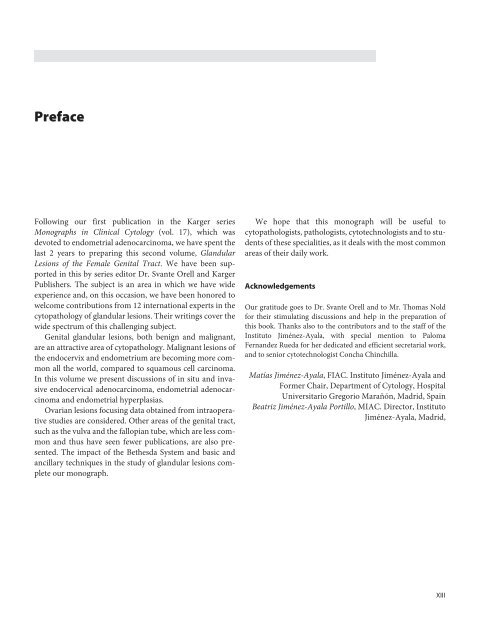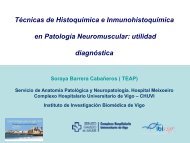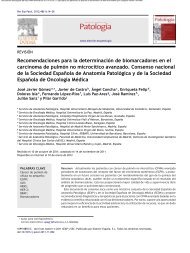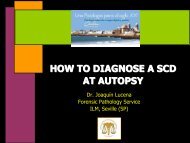Cytopathology of the Glandular Lesions of the Female Genital Tract
Cytopathology of the Glandular Lesions of the Female Genital Tract
Cytopathology of the Glandular Lesions of the Female Genital Tract
You also want an ePaper? Increase the reach of your titles
YUMPU automatically turns print PDFs into web optimized ePapers that Google loves.
PrefaceFollowing our first publication in <strong>the</strong> Karger seriesMonographs in Clinical Cytology (vol. 17), which wasdevoted to endometrial adenocarcinoma, we have spent <strong>the</strong>last 2 years to preparing this second volume, <strong>Glandular</strong><strong>Lesions</strong> <strong>of</strong> <strong>the</strong> <strong>Female</strong> <strong>Genital</strong> <strong>Tract</strong>. We have been supportedin this by series editor Dr. Svante Orell and KargerPublishers. The subject is an area in which we have wideexperience and, on this occasion, we have been honored towelcome contributions from 12 international experts in <strong>the</strong>cytopathology <strong>of</strong> glandular lesions. Their writings cover <strong>the</strong>wide spectrum <strong>of</strong> this challenging subject.<strong>Genital</strong> glandular lesions, both benign and malignant,are an attractive area <strong>of</strong> cytopathology. Malignant lesions <strong>of</strong><strong>the</strong> endocervix and endometrium are becoming more commonall <strong>the</strong> world, compared to squamous cell carcinoma.In this volume we present discussions <strong>of</strong> in situ and invasiveendocervical adenocarcinoma, endometrial adenocarcinomaand endometrial hyperplasias.Ovarian lesions focusing data obtained from intraoperativestudies are considered. O<strong>the</strong>r areas <strong>of</strong> <strong>the</strong> genital tract,such as <strong>the</strong> vulva and <strong>the</strong> fallopian tube, which are less commonand thus have seen fewer publications, are also presented.The impact <strong>of</strong> <strong>the</strong> Be<strong>the</strong>sda System and basic andancillary techniques in <strong>the</strong> study <strong>of</strong> glandular lesions completeour monograph.We hope that this monograph will be useful tocytopathologists, pathologists, cytotechnologists and to students<strong>of</strong> <strong>the</strong>se specialities, as it deals with <strong>the</strong> most commonareas <strong>of</strong> <strong>the</strong>ir daily work.AcknowledgementsOur gratitude goes to Dr. Svante Orell and to Mr. Thomas Noldfor <strong>the</strong>ir stimulating discussions and help in <strong>the</strong> preparation <strong>of</strong>this book. Thanks also to <strong>the</strong> contributors and to <strong>the</strong> staff <strong>of</strong> <strong>the</strong>Instituto Jiménez-Ayala, with special mention to PalomaFernandez Rueda for her dedicated and efficient secretarial work,and to senior cytotechnologist Concha Chinchilla.Matías Jiménez-Ayala, FIAC. Instituto Jiménez-Ayala andFormer Chair, Department <strong>of</strong> Cytology, HospitalUniversitario Gregorio Marañón, Madrid, SpainBeatriz Jiménez-Ayala Portillo, MIAC. Director, InstitutoJiménez-Ayala, Madrid,XIII
















